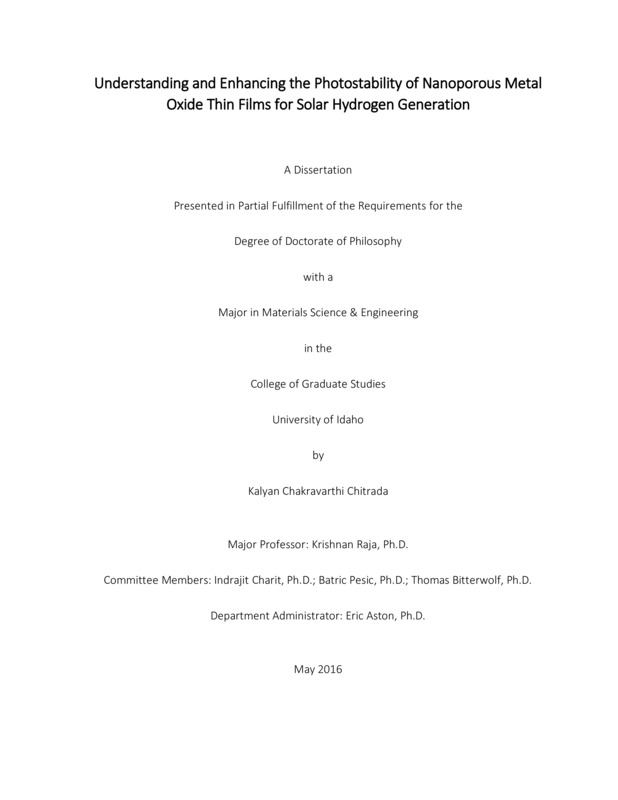Understanding and Enhancing the Photostability of Nanoporous Metal Oxide Thin Films for Solar Hydrogen Generation
Chitrada, Kalyan Chakravarthi. (2016). Understanding and Enhancing the Photostability of Nanoporous Metal Oxide Thin Films for Solar Hydrogen Generation. Theses and Dissertations Collection, University of Idaho Library Digital Collections. https://www.lib.uidaho.edu/digital/etd/items/chitrada_idaho_0089e_10731.html
- Title:
- Understanding and Enhancing the Photostability of Nanoporous Metal Oxide Thin Films for Solar Hydrogen Generation
- Author:
- Chitrada, Kalyan Chakravarthi
- Date:
- 2016
- Keywords:
- Bismuth Oxide Electrochemistry Hydorgen Photoelectrochemical Water Splitting Solar Water Splitting
- Program:
- Chemical and Materials Science Engineering
- Subject Category:
- Materials Science; Chemistry; Physics
- Abstract:
-
Solar water splitting is an environmentally benign process which has received wide attention in the recent years as an alternate method for a clean and safe production of hydrogen. This process employs a semiconductor based photocatalyst, water, and sunlight to produce hydrogen. Metal-oxide based semiconductors are considered to be ideal photocatalytic materials because of their stability against photo-corrosion combined with relatively narrow energy band-gap, appropriately placed band edge positions with reference to oxygen and hydrogen energy levels, less scattering of charges due to wider valence band, high dielectric constant, natural abundance, and non-toxicity. In this dissertation, two metal oxide based semiconductors viz., iron (III) oxide and bismuth (III) oxide were investigated to understand and enhance their photo activity as photoanodes for solar water splitting application.
Iron (III) oxide has a well suited band gap to capture solar spectrum but it suffers from inappropriately positioned band edges, recombination losses due to low electron mobility, and a small minority carrier diffusion length. However, it was hypothesized that the Iron (III) oxide might show interesting photoelectrochemical properties by alloying with 4f elements and shifting the conduction band minimum of the iron oxide favorably to more negative potentials. In the present study, a nanoporous iron oxide layer incorporated with Nd3+ and B3+ was synthesized by electrochemical anodization of a FeNdB alloy. The photoelectrochemical behavior of this oxide was compared with thermally oxidized FeNdB alloy and the iron oxides obtained by anodization and thermal oxidation of pure iron foil. Incorporation of Nd3+ and B3+ in the iron oxide showed a direct bandgap of 2.05 eV, an indirect bandgap of 1.9 eV and shifted the flatband potentials to –0.8 VAg/AgCl in 1 M KOH solution. The FeNdB oxide showed marginally better catalytic activity for the oxygen evolution reaction than pure iron oxide under dark conditions.
The binary bismuth (III) oxide, in spite being a good photocatalytic material, did not receive as much attention as other bismuth based ternary oxides for photoelectrochemical water splitting application. In this present study, large surface area nanoporous bismuth oxide thin films were synthesized by the electrochemical anodization. These anodic oxides exhibited a dual layered structure having a planar inner oxide and nanoporous outer oxide. Effect of the nanoscale dimensions of the oxides on the photoelectrochemical behavior was studied to understand the charge transport, charge recombination behavior, and long term stability of the material. A maximum photo current density of 0.97 mA/cm2 was observed for the sample anodized at 10 V at 1.53 VRHE. The nanoporous anodic oxides showed a charge carrier density in the range of 1.2 x 1017 – 4.8 x 1018 cm-3 without illumination and about 60% increase in the charge carrier density upon illumination. However a decay in photo current was observed for the bismuth oxide samples was due to accumulation of holes on the electrode surface. This hole-accumulation was mitigated by the addition of hole scavengers. Addition of hydrogen peroxide as hole scavenger increased the photo current density by about 4 times in 0.5 M Na2SO4 (pH: 5.8) electrolyte. Addition of H2O2 in 1 M KOH (pH: 13.7) showed an increase-decrease behavior and high photo current density of ~10 mA/cm2 at a bias potential of 0.65 VRHE. The high photo activity observed in this electrolyte was attributed to the in-situ formation of Bi2O4-x phase by the photo-conversion of the β-Bi2O3 at the surface. The photo-converted Bi2O4-x has a smaller band gap (1.4 eV) and therefore harvested more light in the visible region. This in-situ formation of low band gap phases in the presence of H2O2 during solar water splitting is an interesting observation which has been reported for the first time and this will help design material with very high photo-activity.
- Description:
- doctoral, Ph.D., Chemical and Materials Science Engineering -- University of Idaho - College of Graduate Studies, 2016
- Major Professor:
- Raja, Krishnan S
- Committee:
- Pesic, Batric; Charit, Indrajit; Bitterwolf, Thomas
- Defense Date:
- 2016
- Identifier:
- Chitrada_idaho_0089E_10731
- Type:
- Text
- Format Original:
- Format:
- application/pdf
- Rights:
- In Copyright - Educational Use Permitted. For more information, please contact University of Idaho Library Special Collections and Archives Department at libspec@uidaho.edu.
- Standardized Rights:
- http://rightsstatements.org/vocab/InC-EDU/1.0/

